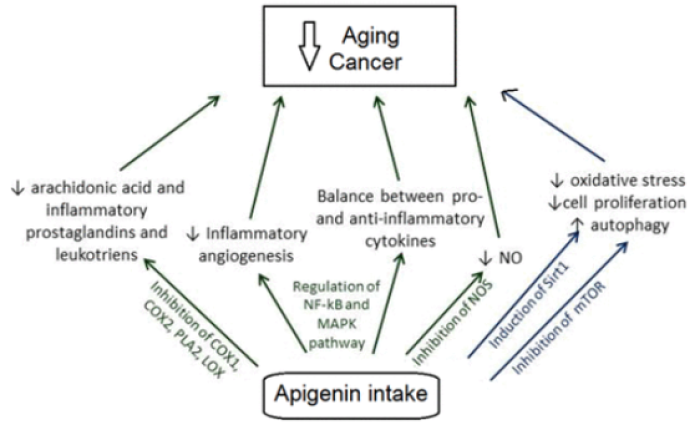Name: Apigenin
Class: herbal supplement; flavonoid
Alias(es): CAS# 520-36-5; 4′,5,7-trihydroxyflavone; Apigenine; Chamomile; Apigenol; Spigenin; Versulin; C.I. Natural Yellow 1
Background: Apigenin is a flavonoid found naturally in a variety of fruits and vegetables, including chamomile, parsley, celery, vine-spinach, artichokes, and oregano[1]. Supplements are available to potentially obtain its senolytic and NAD+ boosting properties, both of which have been demonstrated in human cells (in vitro), and in mice (both in vivo and in vitro). Additionally, in preclinical studies, apigenin supplementation has been shown to protect against and improve skin aging, have antioxidant activity, reduce aging biomarker levels (i.e. AGEs and SASP), improve age-related impairments in motor function and learning/memory, reduce inflammation associated with senescence, relieve muscular and mitochondrial aspects of frailty, and improve vascular aging. See studies in the preclinical section below for references and details. Furthermore, since apigenin is present in chamomile, it is considered Generally Recognized as Safe (GRAS) by the FDA[2], and to date, although there is limited data available, there have been no reports of adverse effects[3].
Is there evidence it works in humans for aging?
No clinical trials have studied or are studying apigenin for treating aging.
Is there evidence it works in preclinical studies for aging?
Model | Vivo/Vitro | Outcome | Reference |
Human cells and mice | In vivo (mice) and in vitro (human cells) | CD38 is a glycoprotein that is primarily responsible for destroying NAD+ and reducing NAD+ levels in mammals with age.
| |
Human (preclinical & clinical trial for skin aging) | In vivo & in vitro |
| |
Mice (d-galactose induced aging) | In vitro & in vivo |
| |
Human | In vitro |
| |
Wistar rats | In vitro | Apigenin exhibited neuroprotective and anti-inflammatory effects when added to cultures of neurons and glial cells from Wistar rats that were subjected to an inflammatory stimulus (LPS and IL-1β). This suggests it may be useful in the treatment of neurodegenerative diseases and aging-related inflammation in the brain. | |
Mice (male C57BL/6) | In vivo | In naturally aged mice, apigenin supplementation:
| |
Mice (C57BL/6N) | In vivo | In naturally aged mice, oral supplementation of apigenin reversed vascular endothelial dysfunction and age-associated aortic stiffening. It also prevented foam cell formation in a cell culture model of atherosclerosis. Its benefits for vascular aging were mediated by increasing nitric oxide (NO), reducing arterial reactive oxygen species (ROS), reducing oxidative stress, increasing antioxidant expression, normalizing collagen and elastin, and reducing AGEs and inflammation. |
Apigenin Mechanisms:
CD38 inhibition by Apigenin stabilizes NAD levels by preventing NAD degradation:
The diagram above is from a review paper by Rajman et al., published in Cell Metabolism in 2018. Apigenin raises NAD+ levels by inhibiting CD38, an enzyme that consumes NAD+.
Senolytic Properties:
The above diagram is from a 2019 review article by Xie et al., published in Natural Product Communications. It is based on an analysis of multiple databases and shows the pathways by which apigenin likely mediates its anti-aging, anti-inflammatory, and anti-cancer effects. Apigenin’s senolytic (senescent-cell killing) and senomorphic (suppression of the senescent cell phenotype) properties are also likely mediated through the above mechanisms.
Are there known safety concerns?
There is limited safety or toxicology data available.
Compound treated as Generally Recognized As Safe in U.S., pursuant to [Public GRAS filing/ DSHEA GRAS Exemption (grandfathered in due to historical use)].
Literature Cited:
2. Substances Added to Food <em>(formerly EAFUS)</em>. (n.d.). Retrieved April 2, 2022, from https://www.cfsanappsexternal.fda.gov/scripts/fdcc/?set=FoodSubstances&id=CHAMOMILEFLOWERAnthemisnobilis&sort=Sortterm_ID&order=ASC&startrow=1&type=basic&search=chamomile


